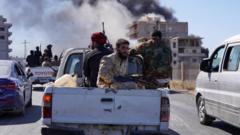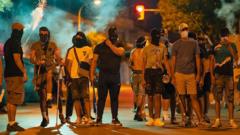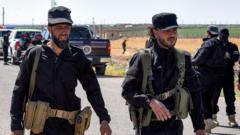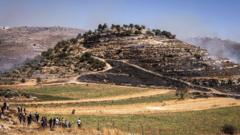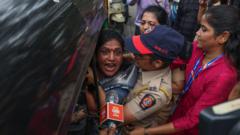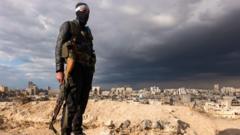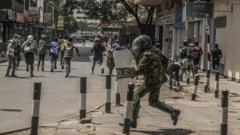In Northern Ireland, a renewed wave of anti-immigrant sentiment has resulted in violent riots, reminiscent of historical sectarian conflicts. Targeted attacks on immigrant communities reveal the ongoing issues of territorialism and social division within the region.
Rising Anti-Immigrant Sentiment Sparks Violence in Northern Ireland

Rising Anti-Immigrant Sentiment Sparks Violence in Northern Ireland
Recent riots and anti-immigrant attacks in Northern Ireland echo the sectarian violence of the past, driven by a resurgence of fear and exclusion.
In Northern Ireland, a series of violent incidents fueled by anti-immigrant sentiment has surfaced, evoking memories of the sectarian troubles that plagued the region for decades. Recent events have turned not only homes into targets but also ignited fiery images of bonfires adorned with effigies, all while revealing persistent social tensions deeply embedded within the community.
The confrontations started notably in Ballymena, where chaos erupted following charges against two boys accused of attempted sexual assault. The peaceful remembrance vigil for the girl after the court proceedings quickly morphed into violent protests aimed at the local Roma community. Riots extended across Northern Ireland within a few days, leading to extensive property damage and the displacement of immigrant families.
Amidst the turmoil, many prominent observers have recognized these violent outbreaks as an expression of a larger cultural and territorial fight, characterized by anti-immigrant hostility. “The historical shades of loyalty and tribalism that marked the Troubles are still present,” Duncan Morrow, a political analyst, stated. “The recent violence signifies a compromised society with pre-existing embers of distrust.”
Areas like Ballymena, known for its traditional Protestant affiliations, saw riots fueled by a mix of community outrage and organized criminal elements. Some neighborhoods have recently witnessed an influx of immigrants, revealing ongoing cultural friction between new residents and long-established communities. Professor Dominic Bryan referred to current immigrant families as “exposed minorities” in neighborhoods largely homogenized by historic demographics.
The involvement of paramilitary groups further complicates the situation. Many of these organizations continue to exert influence over disenfranchised youth, as various factions adopt far-right rhetoric and organize disruptions through social media channels. Authorities are investigating possible connections between the violence and loyalist groups, although no direct allegations have been pinned as of yet.
The recent bonfires, a part of Unionist customs linked to the Twelfth of July celebrations, showcased nativist slogans and even featured effigies of boats filled with migrants. This societal underpinning of anti-immigration sentiment resonates through generations in Northern Ireland, including remnants of the past where similar tactics facilitated campaigns to displace minority Catholic populations.
As tensions escalate, the Northern Ireland Housing Executive has reported that nearly two dozen families have been relocated to temporary shelters for their safety. Despite a consensus that most residents disapprove of violence, observers noted that the collective experience of watching such riots demonstrates a troubling passivity among onlookers. These scenes are reminiscent of past conflicts, filled with individuals who seem to witness violence with a sense of detachment.
The urgent plea from local political figures highlights the dire need for addressing systemic issues related to immigration while underscoring that violence, no matter the provocation, remains unacceptable. “We have serious concerns about immigration,” stated Jonathan Buckley, a member of the Democratic Unionist Party, “but the path to resolving those concerns cannot be through violence.”
The aftermath of these events leaves an indelible mark on Northern Ireland’s contemporary narrative, reminding leaders and citizens alike of the fragility of peace in a region that continues to grapple with its identity and the lessons of its history.


